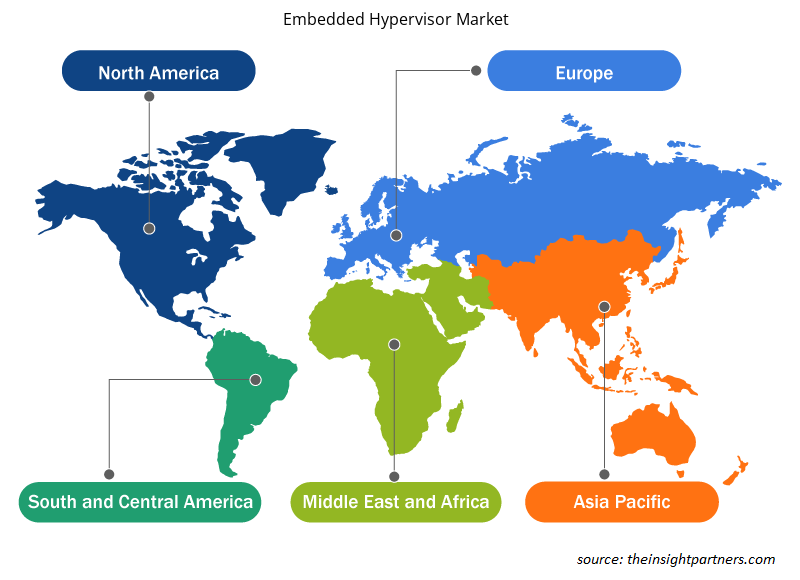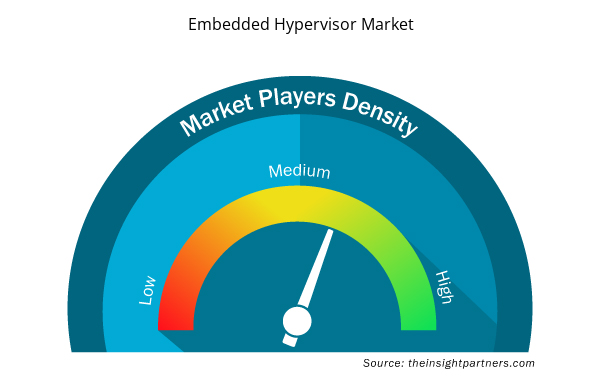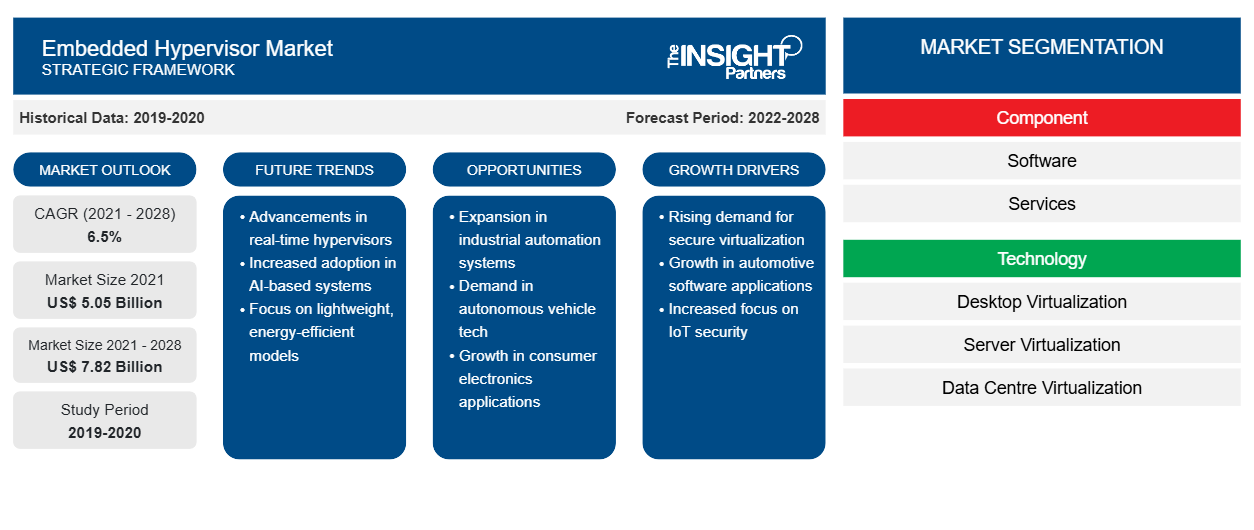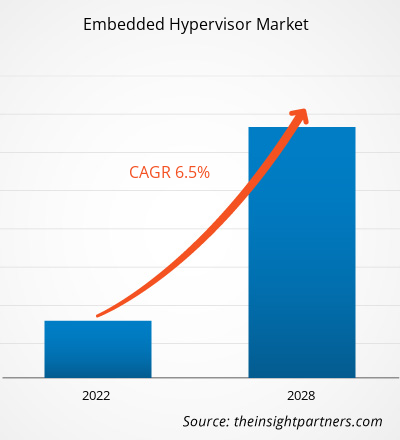嵌入式虚拟机管理程序市场规模预计将从 2021 年的 50.467 亿美元增长到 2028 年的 78.232 亿美元;预计 2021-2028 年期间的复合年增长率为6.5%。
工业自动化通过减少错误和浪费、提高安全性和增加制造过程的灵活性来提高生产率和质量。此外,将实时操作系统 ( RTOS ) 与工业自动化相结合可增强进程调度、内存管理和文件管理,使它们可以作为单个进程运行。因此,垂直工业应用中对RTOS的相关优势和不断增长的需求正在推动对嵌入式虚拟机管理程序的需求,从而推动嵌入式虚拟机管理程序市场的增长。
在过去二十年中,制造业自动化一直是导致工厂车间运营、制造业就业和制造业动态发生转变的持续因素。制造业的当前趋势,例如机器人技术、机器学习和人工智能,使机器能够在一系列活动中匹敌甚至超越人类——包括制造业各个层面所需的认知活动。当任何精益装配线上集成自动化时,生产率将提高 10% 到 20%。此外,工业 4.0 是另一个预计将在未来几年推动制造业发展的趋势。工业 4.0 和工业物联网 ( IIoT )的出现将利用协作机器人和自动导引车的功能,推动制造业的生产力。消费电子产品、医疗保健相关产品、汽车和国防工业的制造是一些在制造装配线上大量使用RTOS 的著名垂直行业。因此,工业自动化领域的这些增长前景正在推动RTOS的采用,这将进一步增强未来几年嵌入式虚拟机管理程序的市场活力。
定制此报告以满足您的需求
您可以免费定制任何报告,包括本报告的部分内容、国家级分析、Excel 数据包,以及为初创企业和大学提供优惠和折扣
- 获取此报告的关键市场趋势。这个免费样品将包括数据分析,从市场趋势到估计和预测。
COVID-19 疫情对北美嵌入式虚拟机管理程序市场的影响
由于政府出台了促进创新和加强基础设施能力的优惠政策,北美在全球新兴技术的接受度和发展率最高。因此,任何对行业的影响都预计将对该地区的经济发展产生不利影响。值得注意的是,美国是世界上受疫情影响最严重的国家之一,COVID-19 危机对 IT、汽车和电信等多个行业产生了连锁影响。这些行业的运营中断,阻碍了 2020 年上半年的业务动态。
新冠疫情加速了向居家办公模式的转变,增加了对网络安全的需求。因此,嵌入式虚拟机管理程序业务从疫情中受益。新冠疫情后,嵌入式虚拟机管理程序市场的增长前景,例如采用物联网实现可持续发展、转向云存储、人工智能的日益普及以及安全的远程访问,都促进了该地区在物联网、云计算和人工智能平台中使用嵌入式虚拟机管理程序。
嵌入式虚拟机管理程序市场洞察
嵌入式虚拟机管理程序在垂直工业应用中的采用日益增多
大多数垂直行业的企业都意识到了物联网、通信和传感器的重要性,这为将传感器集成到设备中铺平了道路。各种业务功能(如供应链规划和物流以及汽车、消费电子设备、医疗保健、航空航天和国防等垂直行业的制造)都可以得到优化,从而提高盈利能力。将支持传感器的设备集成到业务流程中对公司的资产负债表产生了积极影响,从而导致其需求增加。各种终端使用垂直行业的市场增长迅速,物联网在未来几年将变得更加突出。
自动驾驶汽车的发展正在稳步推进,一些知名汽车制造商正在与技术先进的公司合作。自动驾驶汽车在ADAS(高级驾驶辅助系统)构建的平台上发展,例如福特、通用汽车、日产、特斯拉、梅赛德斯和本田等公司已在这些汽车的研发上投资了数十亿美元。此外,包括苹果、IBM 和英特尔在内的科技巨头也与领先的汽车制造商合作,以保持竞争力。预计自动驾驶汽车将上路并实现商业化。自适应制动、自动泊车、倒车摄像头和自动巡航控制等 ADAS(高级驾驶辅助系统)的出现进一步提高了车内乘客的安全性。共享移动服务是汽车生态系统的另一个趋势。预计这些车辆中将集成高度先进的传感器,以实现高效通信。因此,预计这些汽车电子趋势将在预测期内为嵌入式虚拟机管理程序市场参与者提供丰厚的机会。
全球互联网活动的增加和安全强制要求的提高是市场趋势的关键因素。随着使用互联网的人数增加,网络犯罪率也在上升。互联网用户数量正在增加,因此保护个人信息至关重要。不道德行为和网络安全威胁的增加推动了嵌入式虚拟机管理程序的采用。此外,软件驱动解决方案的采用率不断提高以及对消费电子产品的需求不断增长是推动嵌入式虚拟机管理程序部署的一些趋势因素。因此,这些趋势因素正在推动嵌入式虚拟机管理程序市场的增长。
基于组件的市场洞察
根据组件,嵌入式虚拟机管理程序市场细分为解决方案和服务。2021 年,解决方案部分占据了嵌入式虚拟机管理程序最大的市场份额。
基于技术的市场洞察
嵌入式虚拟机管理程序市场按技术分析,嵌入式虚拟机管理程序市场细分为桌面虚拟化、服务器虚拟化和数据中心虚拟化。2021 年,桌面虚拟化部分占据了嵌入式虚拟机管理程序最大的市场份额。
基于企业规模的市场洞察
嵌入式虚拟机管理程序市场按企业规模进行分析,嵌入式虚拟机管理程序市场细分为中小型企业和大型企业。2021 年,大型企业部门占据了更大的嵌入式虚拟机管理程序市场份额。
嵌入式虚拟机管理程序市场区域洞察
Insight Partners 的分析师已详尽解释了预测期内影响嵌入式虚拟机管理程序市场的区域趋势和因素。本节还讨论了北美、欧洲、亚太地区、中东和非洲以及南美和中美洲的嵌入式虚拟机管理程序市场细分和地理位置。

- 获取嵌入式虚拟机管理程序市场的区域特定数据
嵌入式虚拟机管理程序市场报告范围
| 报告属性 | 细节 |
|---|---|
| 2021 年市场规模 | 50.5亿美元 |
| 2028 年市场规模 | 78.2亿美元 |
| 全球复合年增长率(2021 - 2028) | 6.5% |
| 史料 | 2019-2020 |
| 预测期 | 2022-2028 |
| 涵盖的领域 | 按组件
|
| 覆盖地区和国家 | 北美
|
| 市场领导者和主要公司简介 |
|
嵌入式虚拟机管理程序市场参与者密度:了解其对业务动态的影响
嵌入式虚拟机管理程序市场正在快速增长,这得益于最终用户需求的不断增长,而这些需求又源于消费者偏好的不断变化、技术进步以及对产品优势的认识不断提高等因素。随着需求的增加,企业正在扩大其产品范围,进行创新以满足消费者需求,并利用新兴趋势,从而进一步推动市场增长。
市场参与者密度是指在特定市场或行业内运营的企业或公司的分布情况。它表明在给定市场空间中,相对于其规模或总市场价值,有多少竞争对手(市场参与者)存在。
在嵌入式虚拟机管理程序市场运营的主要公司有:
- Citrix 系统公司
- IBM 公司
- 微软
- VMware 公司
- 风河系统公司
免责声明:上面列出的公司没有按照任何特定顺序排列。

- 获取嵌入式虚拟机管理程序市场顶级关键参与者的概述
基于行业的市场洞察
嵌入式虚拟机管理程序市场按行业分析,嵌入式虚拟机管理程序市场细分为 BFSI、IT 和电信、航空航天和国防、汽车、医疗保健、运输、其他。2021 年,BFSI 部门占据了嵌入式虚拟机管理程序最大的市场份额。
嵌入式虚拟机管理程序市场的参与者采用合并、收购和市场计划等策略来保持其在市场中的地位。以下列出了一些主要参与者的发展:
- 2021 年 1 月,Citrix Systems, Inc. 收购了 Wrike, Inc.,并致力于更新其统一数字工作空间技术组合,其中包括桌面和应用程序虚拟化工具以及内容协作软件。
- 2020 年 3 月,VMware 推出了 VMware Partner Connect,这是一项全新、大幅简化且灵活的计划,旨在让合作伙伴能够通过一份统一的合同,以符合其业务模式的方式与 VMware 开展业务。VMware Partner Connect 使合作伙伴能够灵活地满足客户需求,使 VMware 技术和服务机会更容易获得。合作伙伴现在拥有增强的体验,可提供简便性、选择和创新,同时根据合作伙伴为客户带来的价值对其进行认可和奖励。
公司简介
- Citrix 系统公司
- IBM 公司
- 微软公司
- VMware 公司
- 风河系统公司
- 恩智浦半导体
- 泰雷兹集团
- Fent 创新软件解决方案;SL
- Lynx 软件技术公司
- 西门子股份公司
- 历史分析(2 年)、基准年、预测(7 年)及复合年增长率
- PEST 和 SWOT 分析
- 市场规模价值/数量 - 全球、区域、国家
- 行业和竞争格局
- Excel 数据集



Report Coverage
Revenue forecast, Company Analysis, Industry landscape, Growth factors, and Trends

Segment Covered
This text is related
to segments covered.

Regional Scope
North America, Europe, Asia Pacific, Middle East & Africa, South & Central America

Country Scope
This text is related
to country scope.
常见问题
The key companies operating in the embedded hypervisor market that are profiled in the report include Citrix Systems, Inc., IBM Corporation, Microsoft Corporation, VMware, Inc., Wind River Systems, Inc., NXP Semiconductors, Thales Group, Fent Innovative Software Solution, S.L., Lynx Software Technologies, and Siemens AG.
Based on application, the global embedded hypervisor market is segmented into the BFSI, IT and Telecom, Aerospace and Defense, Automotive, Healthcare, Transportation, and Others. The BFSI segment accounted for the largest share of the embedded hypervisor market in 2020. Moreover, the Aerospace and Defense segment is projected to grow at a faster pace during the forecast period.
The growing adoption of embedded hypervisor in vertical of industrial applications along with significant advancement in technology are the key trends attributed to the growth of embedded hypervisor market.
Based on technology, the global embedded hypervisor market is segmented into desktop virtualization, server virtualization, and data center virtualization. The desktop virtualization segment accounted for the largest share of the embedded hypervisor market in 2020.
Increasing popularity of cloud computing & virtualization technology is holding potential growth opportunity for the market growth. Virtualization technologies play a crucial role in efficiently delivering Infrastructure-as-a-Service (IaaS) solutions for cloud computing and provide a virtual environment for storage, memory, and networking. Hence, increasing spending for adopting advanced technologies and the growing popularity of cloud computing technology are paving new opportunities for deploying embedded hypervisors in the ecosystem, which is anticipated to drive the market growth over the forecast period.
The major factors driving the growth of the embedded hypervisor market is growing demand for safety & security systems of modules, increasing investment in IoT devices in the manufacturing sector, and increase in preference for real-time operating system in industrial automation sector. Furthermore, growing adoption of embedded hypervisor in vertical of industrial applications is also to increase the market growth.
Trends and growth analysis reports related to Technology, Media and Telecommunications : READ MORE..
The List of Companies - Embedded Hypervisor Market
- Citrix Systems Inc.
- IBM Corporation
- Microsoft
- VMware, Inc
- Wind River Systems, Inc.
- NXP Semiconductor
- Thales Group
- Fent Innovation software solution, S.L
- Lynx Software Technologies, Inc.
- Siemens
The Insight Partners performs research in 4 major stages: Data Collection & Secondary Research, Primary Research, Data Analysis and Data Triangulation & Final Review.
- Data Collection and Secondary Research:
As a market research and consulting firm operating from a decade, we have published and advised several client across the globe. First step for any study will start with an assessment of currently available data and insights from existing reports. Further, historical and current market information is collected from Investor Presentations, Annual Reports, SEC Filings, etc., and other information related to company’s performance and market positioning are gathered from Paid Databases (Factiva, Hoovers, and Reuters) and various other publications available in public domain.
Several associations trade associates, technical forums, institutes, societies and organization are accessed to gain technical as well as market related insights through their publications such as research papers, blogs and press releases related to the studies are referred to get cues about the market. Further, white papers, journals, magazines, and other news articles published in last 3 years are scrutinized and analyzed to understand the current market trends.
- Primary Research:
The primarily interview analysis comprise of data obtained from industry participants interview and answers to survey questions gathered by in-house primary team.
For primary research, interviews are conducted with industry experts/CEOs/Marketing Managers/VPs/Subject Matter Experts from both demand and supply side to get a 360-degree view of the market. The primary team conducts several interviews based on the complexity of the markets to understand the various market trends and dynamics which makes research more credible and precise.
A typical research interview fulfils the following functions:
- Provides first-hand information on the market size, market trends, growth trends, competitive landscape, and outlook
- Validates and strengthens in-house secondary research findings
- Develops the analysis team’s expertise and market understanding
Primary research involves email interactions and telephone interviews for each market, category, segment, and sub-segment across geographies. The participants who typically take part in such a process include, but are not limited to:
- Industry participants: VPs, business development managers, market intelligence managers and national sales managers
- Outside experts: Valuation experts, research analysts and key opinion leaders specializing in the electronics and semiconductor industry.
Below is the breakup of our primary respondents by company, designation, and region:

Once we receive the confirmation from primary research sources or primary respondents, we finalize the base year market estimation and forecast the data as per the macroeconomic and microeconomic factors assessed during data collection.
- Data Analysis:
Once data is validated through both secondary as well as primary respondents, we finalize the market estimations by hypothesis formulation and factor analysis at regional and country level.
- Macro-Economic Factor Analysis:
We analyse macroeconomic indicators such the gross domestic product (GDP), increase in the demand for goods and services across industries, technological advancement, regional economic growth, governmental policies, the influence of COVID-19, PEST analysis, and other aspects. This analysis aids in setting benchmarks for various nations/regions and approximating market splits. Additionally, the general trend of the aforementioned components aid in determining the market's development possibilities.
- Country Level Data:
Various factors that are especially aligned to the country are taken into account to determine the market size for a certain area and country, including the presence of vendors, such as headquarters and offices, the country's GDP, demand patterns, and industry growth. To comprehend the market dynamics for the nation, a number of growth variables, inhibitors, application areas, and current market trends are researched. The aforementioned elements aid in determining the country's overall market's growth potential.
- Company Profile:
The “Table of Contents” is formulated by listing and analyzing more than 25 - 30 companies operating in the market ecosystem across geographies. However, we profile only 10 companies as a standard practice in our syndicate reports. These 10 companies comprise leading, emerging, and regional players. Nonetheless, our analysis is not restricted to the 10 listed companies, we also analyze other companies present in the market to develop a holistic view and understand the prevailing trends. The “Company Profiles” section in the report covers key facts, business description, products & services, financial information, SWOT analysis, and key developments. The financial information presented is extracted from the annual reports and official documents of the publicly listed companies. Upon collecting the information for the sections of respective companies, we verify them via various primary sources and then compile the data in respective company profiles. The company level information helps us in deriving the base number as well as in forecasting the market size.
- Developing Base Number:
Aggregation of sales statistics (2020-2022) and macro-economic factor, and other secondary and primary research insights are utilized to arrive at base number and related market shares for 2022. The data gaps are identified in this step and relevant market data is analyzed, collected from paid primary interviews or databases. On finalizing the base year market size, forecasts are developed on the basis of macro-economic, industry and market growth factors and company level analysis.
- Data Triangulation and Final Review:
The market findings and base year market size calculations are validated from supply as well as demand side. Demand side validations are based on macro-economic factor analysis and benchmarks for respective regions and countries. In case of supply side validations, revenues of major companies are estimated (in case not available) based on industry benchmark, approximate number of employees, product portfolio, and primary interviews revenues are gathered. Further revenue from target product/service segment is assessed to avoid overshooting of market statistics. In case of heavy deviations between supply and demand side values, all thes steps are repeated to achieve synchronization.
We follow an iterative model, wherein we share our research findings with Subject Matter Experts (SME’s) and Key Opinion Leaders (KOLs) until consensus view of the market is not formulated – this model negates any drastic deviation in the opinions of experts. Only validated and universally acceptable research findings are quoted in our reports.
We have important check points that we use to validate our research findings – which we call – data triangulation, where we validate the information, we generate from secondary sources with primary interviews and then we re-validate with our internal data bases and Subject matter experts. This comprehensive model enables us to deliver high quality, reliable data in shortest possible time.


 获取此报告的免费样本
获取此报告的免费样本